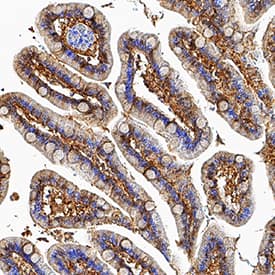Human/Mouse FABP2/I-FABP Antibody
R&D Systems, part of Bio-Techne | Catalog # MAB30781

Key Product Details
Species Reactivity
Applications
Label
Antibody Source
Product Specifications
Immunogen
Ala2-Asp132
Accession # P12104
Specificity
Clonality
Host
Isotype
Scientific Data Images for Human/Mouse FABP2/I-FABP Antibody
Detection of Human and Mouse FABP2/I‑FABP by Western Blot.
Western blot shows lysates of human small intestine tissue and mouse small intestine tissue. PVDF membrane was probed with 2 µg/mL of Mouse Anti-Human FABP2/I-FABP Monoclonal Antibody (Catalog # MAB30781) followed by HRP-conjugated Anti-Mouse IgG Secondary Antibody (Catalog # HAF018). A specific band was detected for FABP2/I-FABP at approximately 14 kDa (as indicated). This experiment was conducted under reducing conditions and using Immunoblot Buffer Group 1.FABP2/I‑FABP in Human Small Intestine.
FABP2/I-FABP was detected in perfusion fixed paraffin-embedded sections of human small intestine using Mouse Anti-Human/Mouse FABP2/I-FABP Monoclonal Antibody (Catalog # MAB30781) at 5 µg/mL for 1 hour at room temperature followed by incubation with the Anti-Mouse IgG VisUCyte™ HRP Polymer Antibody (Catalog # VC001). Tissue was stained using DAB (brown) and counterstained with hematoxylin (blue). Specific staining was localized to cytoplasm in epithelial cells. View our protocol for IHC Staining with VisUCyte HRP Polymer Detection Reagents.Applications for Human/Mouse FABP2/I-FABP Antibody
Immunohistochemistry
Sample:
Perfusion fixed paraffin-embedded sections of human small intestine
Western Blot
Sample: Human small intestine tissue and mouse small intestine tissue
Human FABP2 Sandwich Immunoassay
Use in combination with these reagents:
- Detection Reagent: Human FABP2/I-FABP Biotinylated Antibody (Catalog # BAF3078)
- Standard: Recombinant Human FABP2/I-FABP Protein, CF (Catalog # 2694-CL/CF)
Reviewed Applications
Read 4 reviews rated 4.5 using MAB30781 in the following applications:
Formulation, Preparation, and Storage
Purification
Reconstitution
Formulation
Shipping
Stability & Storage
- 12 months from date of receipt, -20 to -70 °C as supplied.
- 1 month, 2 to 8 °C under sterile conditions after reconstitution.
- 6 months, -20 to -70 °C under sterile conditions after reconstitution.
Background: FABP2/I-FABP
Fatty acid binding protein-2 (FABP2; also I- or intestinal FABP) is a member of a large superfamily of lipid binding proteins that are expressed in a tissue specific manner (1‑3). FABP2 is one of nine cytoplasmic FABPs that are 14‑15 kDa in size and range from 126‑134 amino acids (aa) in length (2). Although all are highly conserved in their tertiary structure, there is only modest aa identity between any two members. Nevertheless, based on aa sequence, the nine FABP family members have been shown to form three subgroups, with FABP2/I-FABP linked with liver/L-FABP and heart/H-FABP (2). The designation of a tissue type, such as intestinal, does not suggest the binding protein is universally expressed in all cell types that make up the organ or tissue. Human I-FABP, the product of the FABP-2 gene, is a 132 aa cytosolic protein that shows a flattened beta-barrel structure (called a beta-clam) generated by a series of antiparallel beta-strands and two alpha-helices (1, 2, 4). Preferred ligands for FABP2 include sixteen to twenty carbon long chain fatty acids (4). It is suggested that ligands first bind to the outside of the molecule, and this binding subsequently induces a conformational change in the binding protein, resulting in “internalization” of the ligand.(1) An Ala-to-Thr polymorphism at position # 54 has been reported to potentially impact FABP2 function (2). This polymorphism has been suggested to be associated with an increased risk of type II diabetes. To date, the evidence appears to be equivocal (1, 2). This polymorphism may, however, have unusual metabolic effects depending upon the type of diet involved (1, 5). Human FABP-2 is 78%, 82% and 86% aa identical to mouse, rat and canine FABP2, respectively. It also shows 33% and 24% aa identity to human H-FABP and L‑FABP, respectively. FABP2 is proposed to transport fatty acids (FA) into cells, increase FA availability to enzymes, protect cell structures from FA attack, and target FA to transcription factors in the nuclear lumen (3).
References
- Weiss, E.P. et al. (2002) Physiol. Genomics 10:145.
- Zimmerman, A.W. and J.H. Veerkamp (2002) Cell. Mol. Life Sci. 59:1096.
- Haunerland, N.H. and F. Spener (2004) Prog. Lipid Res. 43:328.
- Sweetser, D.A. et al. (1987) J. Biol. Chem. 262:16060.
- Dworatzek, P. et al. (2004) Am. J. Clin. Nutr. 79:1110.
Long Name
Alternate Names
Gene Symbol
UniProt
Additional FABP2/I-FABP Products
Product Documents for Human/Mouse FABP2/I-FABP Antibody
Product Specific Notices for Human/Mouse FABP2/I-FABP Antibody
For research use only

